Last updated on March 28, 2024
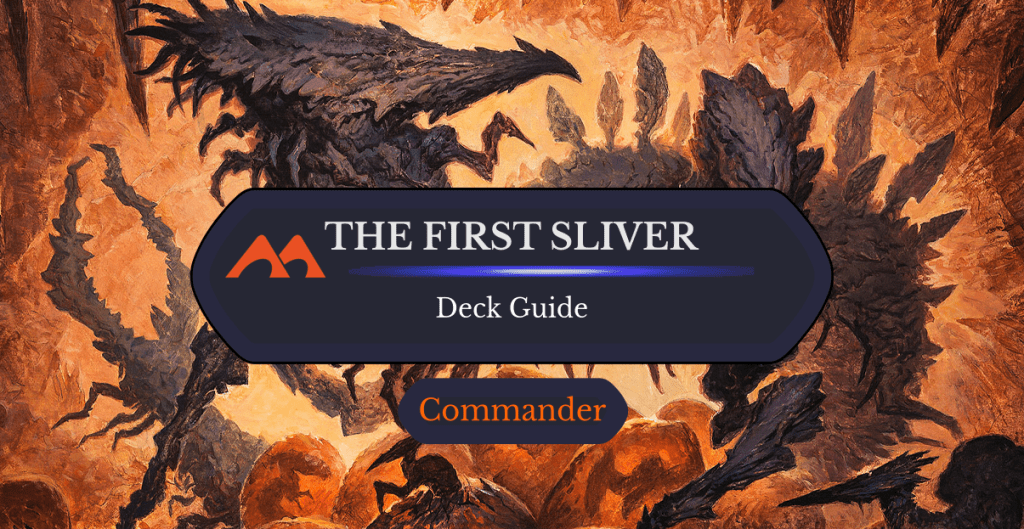
The First Sliver | Illustration by Svetlin Velinov
The flavor for the cascade mechanic is ambivalent. There isn’t much out there regarding what a cascaded spell “looks” like. I’ve always imagined it as a sort of magical overload, where a second spell springs forth from the first one.
Now, picture this: The First Sliver grants cascade to all your sliver spells, which in turn cascade into further sliver spells. A magical tidal wave of swarming bodies! A never-ending flood of slivers buzzing forth from your library!
The First Sliver does just that and offers a unique style of play compared to other sliver tribal decks. Let’s hop right in and see what makes it so different!
The Deck

Icon of Ancestry | Illustration by Chris Seaman
Commander (1)
Creature (42)
Galerider Sliver
Sidewinder Sliver
Striking Sliver
Virulent Sliver
Crypt Sliver
Gemhide Sliver
Heart Sliver
Hibernation Sliver
Manaweft Sliver
Muscle Sliver
Predatory Sliver
Quick Sliver
Sentinel Sliver
Sinew Sliver
Venom Sliver
Winged Sliver
Belligerent Sliver
Blade Sliver
Harmonic Sliver
Homing Sliver
Lavabelly Sliver
Necrotic Sliver
Shadow Sliver
Syphon Sliver
Bonescythe Sliver
Bonesplitter Sliver
Essence Sliver
Mesmeric Sliver
Root Sliver
Watcher Sliver
Battle Sliver
Brood Sliver
Might Sliver
Sliver Hivelord
Sliver Legion
Thorncaster Sliver
Battering Sliver
Constricting Sliver
Fury Sliver
Megantic Sliver
Groundshaker Sliver
Morophon, the Boundless
Instant (5)
Brainstorm
Reclaim
Fracture
Harrow
Shared Summons
Sorcery (8)
Ancestral Vision
Glimpse of Tomorrow
Dreadbore
Farseek
Cultivate
Dream Cache
Kodama's Reach
Patriarch's Bidding
Enchantment (1)
Artifact (9)
Brainstone
Sol Ring
Wayfarer's Bauble
Arcane Signet
Pillar of Origins
Chromatic Lantern
Commander's Sphere
Icon of Ancestry
Door of Destinies
Land (34)
Akoum Refuge
Blossoming Sands
Command Tower
Crystal Quarry
Dismal Backwater
Forest x5
Gruul Guildgate
Island x2
Jungle Hollow
Mountain x4
Path of Ancestry
Plains x3
Rugged Highlands
Scoured Barrens
Sejiri Refuge
Sliver Hive
Stomping Ground
Swamp x3
Swiftwater Cliffs
Temple Garden
Thornwood Falls
Wind-Scarred Crag
This The First Sliver Commander deck is similar to a lot of other sliver decks. It’s heavily skewed towards playing and attacking with sliver creatures.
You use The First Sliver’s cascade effects to cheat more slivers into play, setting up the top of your library through scrying effects to cascade into just the right card. You win via combat damage from an unstoppable army of slivers, or by infinitely damaging your opponents with the Morophon, the Boundless–Hibernation Sliver–Lavabelly Sliver–Essence Sliver combo.
The Commander

The First Sliver is the latest generation in a long line of legendary sliver creatures. It doesn’t have the utility of Sliver Overlord or Sliver Queen and it doesn’t buff your board the same way Sliver Hivelord and Sliver Legion do. No, The First Sliver is a more patrician choice that requires nuanced forethought when deckbuilding. Just slamming each and every sliver you can fit into this deck will yield poor results.
The First Sliver can out-value your opponents very quickly with the right set up. The key is preparing the top of your library for a cascade spell with Brainstorm-like effects and then cascading two spells for the price of one.
The Hive
Obviously a sliver deck has to include slivers. You’re favoring some of the higher-mana value slivers, giving you the most options for spells to cascade into.

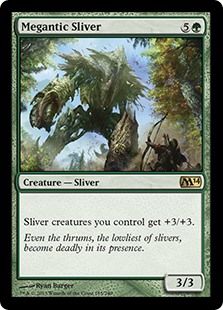
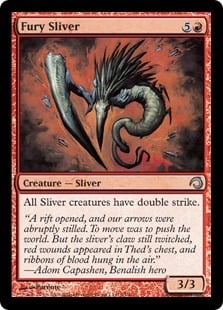

Your biggest cards are Groundshaker Sliver, Megantic Sliver, and Fury Sliver. All three are great combat buffs for your board of slivers and can cascade into just about anything else in this deck. Morophon, the Boundless is technically bigger, but it occupies a different role.
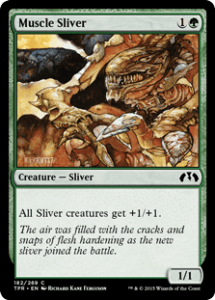
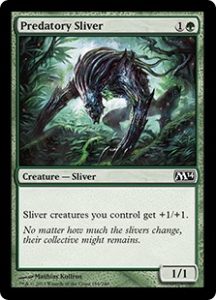
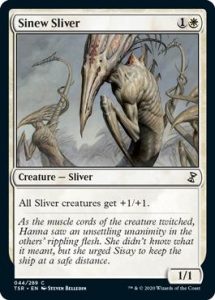
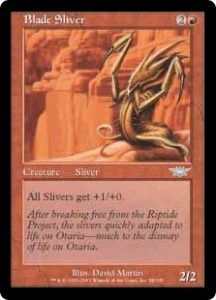
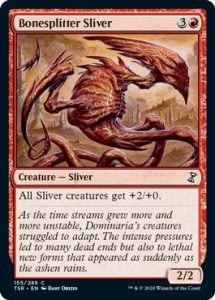
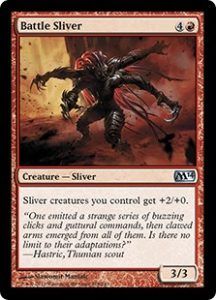

The bread-and-butter of any sliver deck are the lords with buff effects: Muscle Sliver, Predatory Sliver, Sinew Sliver, Blade Sliver, Bonesplitter Sliver, Battle Sliver, and Might Sliver. It only takes a few in play to turn your weak little slivers into huge threats.
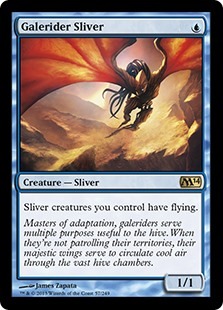
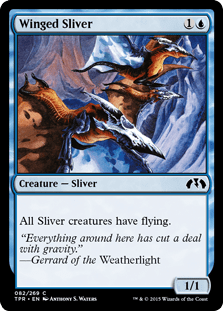

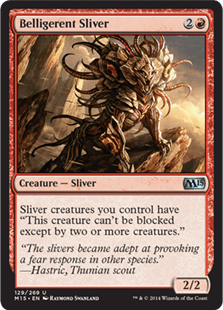
Speaking of combat threats, a lot of your slivers grant keywords to swarm. Galerider Sliver, Winged Sliver, and Shadow Sliver bring some much-needed evasion to your board, with Belligerent Sliver also filling this role.
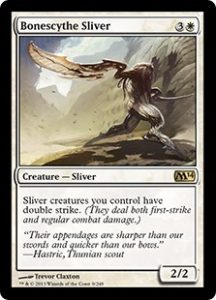
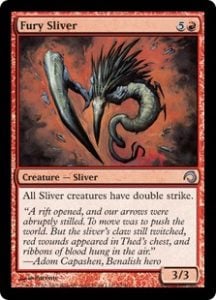
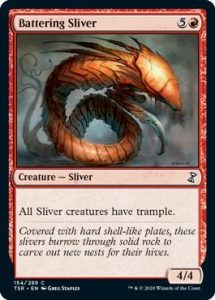

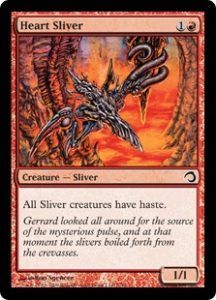
Bonescythe Sliver, Fury Sliver, and Battering Sliver can turn a few big medium-sized slivers into real damage. Especially if you can surprise your opponent with a cascaded Cloudshredder Sliver or Heart Sliver.
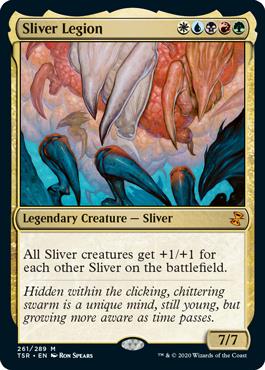
Sliver Legion is your “Coat of Arms on-a-body,” and I’ve played more than one game where I’d rather scoop than do the math on my creatures’ new power and toughness.
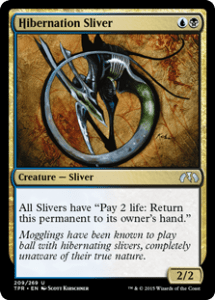
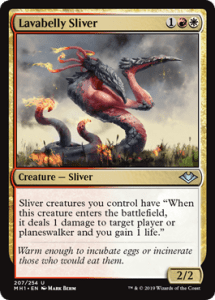
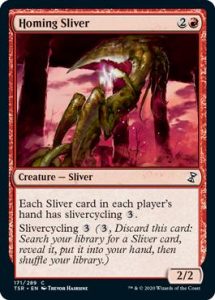
To maximize on sliver spells to cascade with you’re running several “utility” slivers; those too risky to lose in combat. Hibernation Sliver and Lavabelly Sliver are two parts to a combo with Morophon, the Boundless, Essence Sliver, and The First Sliver. These cards, as well as Homing Sliver, are a bit too valuable to just toss into combat. If you’re looking to assemble this combo and win, that is.
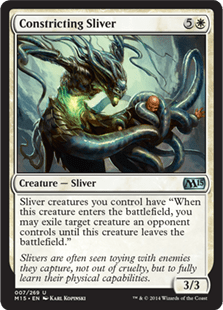

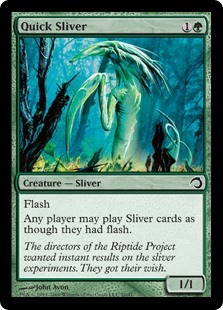
Constricting Sliver is a pseudo-Banisher Priest that makes every sliver a Banisher Priest as well. Root Sliver shuts down anyone’s chances of stopping you from cascading out of control, and Quick Sliver lets you wait until an opponent's tapped out to start casting.
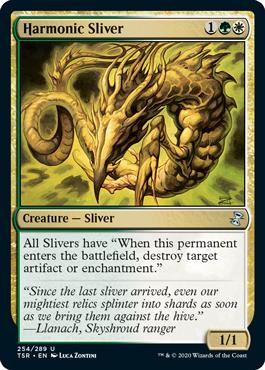
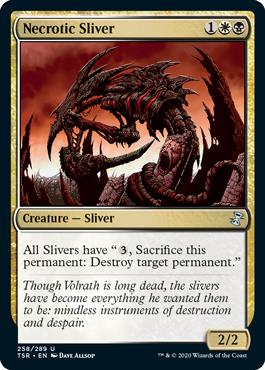

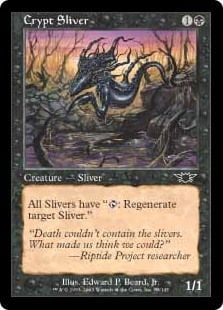
Harmonic Sliver and Necrotic Sliver take the place of your usual targeted removal, and Diffusion Sliver and Crypt Sliver help keep your slivers on the field.

Mesmeric Sliver is just here for fun! Fateseal is a really goofy mechanic and you should exploit it whenever possible.

Finally, we’re including one faux-Sliver. Morophon, the Boundless is a powerful changeling lord that has the added bonus of making our commander free! Morophon’s also essential to our game-ending combo, and should be protected if at all possible.
Just a Little Off the Top
Cascading into just the right spell is required for this deck to run. It’s how you’ll generate most of your advantage and cast anything that’s not a sliver.
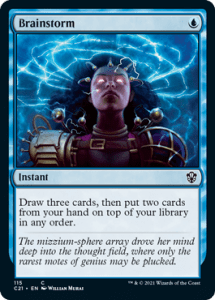
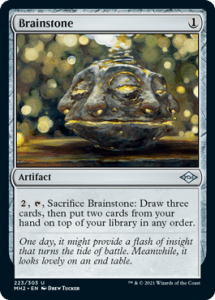
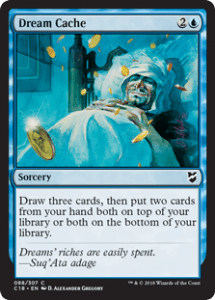
Brainstorm and Brainstone are two easy ways to turn a Patriarch's Bidding in your hand into one on the stack. Dream Cache is sorcery-speed but can still dig and set up the top of your library for some cascading effects.

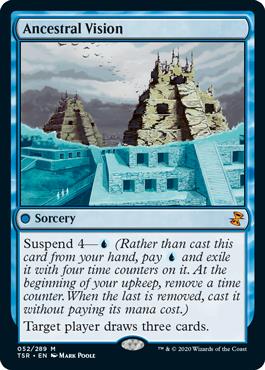
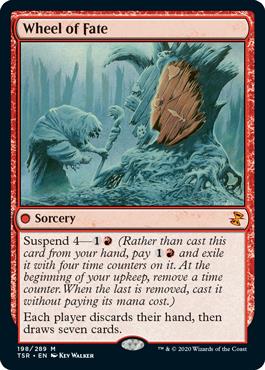

You also want to have some guaranteed great hits for your cascading madness, so you’re running Inevitable Betrayal, Ancestral Vision, Wheel of Fate, and Glimpse of Tomorrow. Glimpse is mostly another “for fun” pick, but don’t underestimate just how many slivers you can immediately replace.
Tribalize
It’s foolish to run a tribal deck without at least a few of the tribal synergy cards. There are tons of classics to choose from, but I’ve made a few specific choices to play to our cascade theme.
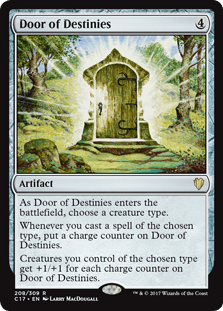
Door of Destinies gets its charge counters off casts, so your Door will still charge up even if a sliver or two gets countered.
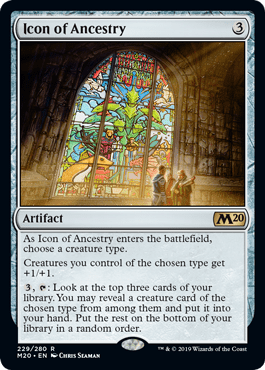
You’re also running Icon of Ancestry mainly for its activated ability. Moving spells to the bottom of your library isn’t optimal for a deck that cascades, so you mainly use it to pull your combo pieces out or grab a small sliver to filter through your library.
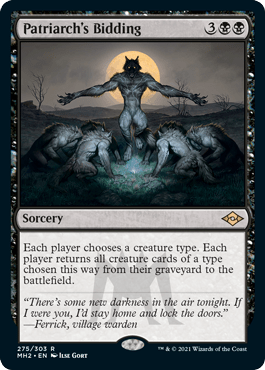
But why just grab one when you could grab them all? In place of the usual creature recursion you use Patriarch's Bidding to reanimate every sliver in your graveyard should you find yourself on the destructive end of a board wipe.
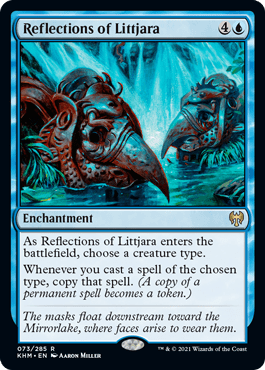
You also have a new favorite for tribal decks: Reflections of Littjara. Any of the “lord” slivers make great targets for this enchantment, plus you can double up on the pseudo-lifegain effect provided by Essence Sliver since it isn’t keyworded. Or you can just bank some extra copies of those combo pieces, making your game plan harder to disrupt.
The Three Rs: Ramp, Removal, Recursion
Even in a tribe as diverse as slivers (or perhaps because they’re so diverse) you need to look towards non-permanent spells to fill some missing slots in your toolbox.
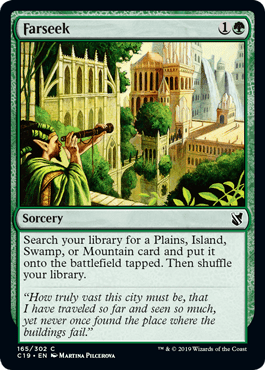
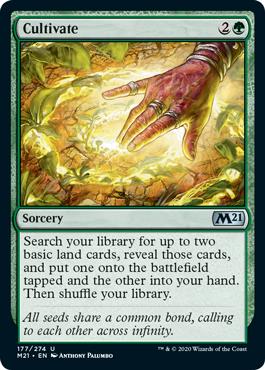
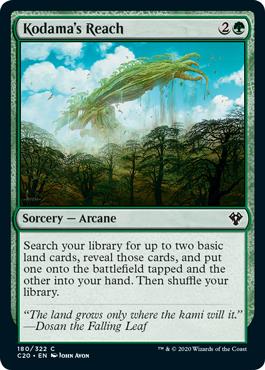

Five-color decks are the hardest to fix mana for, so you’re running four different land-fetching spells: Farseek, Cultivate, Kodama's Reach, and Harrow. You’ll play catch-up for the rest of the game if you can’t get your mana right early.

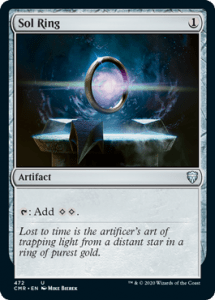
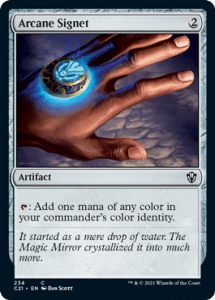
You also have Pillar of Origins, a 2-drop mana rock you can only use on your sliver spells, plus the ubiquitous Sol Ring and Arcane Signet.
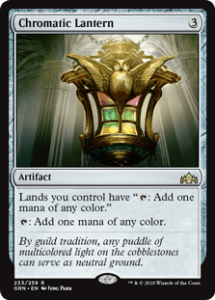

Chromatic Lantern and Commander's Sphere are here just to make sure you have access to all five colors as early as possible.
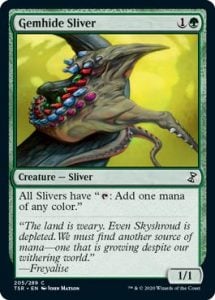
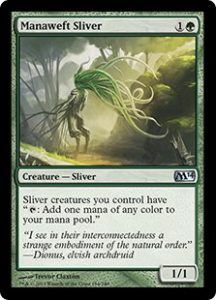
Make sure to use Gemhide Sliver and Manaweft Sliver as well. An entire board of mana dorks can basically sew up the game on the following turn.

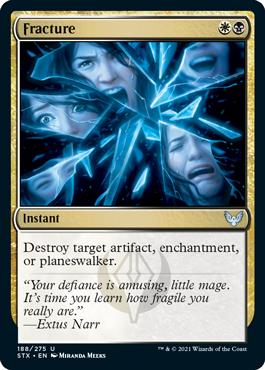
You’re light on single-target removal so you have Dreadbore and Fracture. Both are two mana so you can easily hit them off your cascade effects.
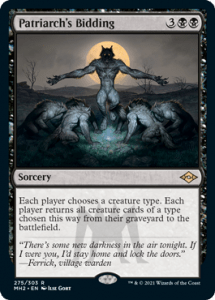
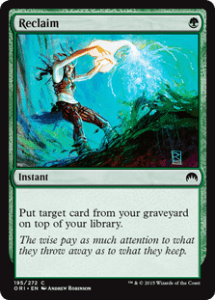
Besides the aforementioned Patriarch's Bidding you also have Reclaim to return a single card from your library. Since Reclaim is instant-speed you can surprise your opponents with a spell from your graveyard after casting a cascaded sliver.
The Mana Base
Balancing your mana sources in a 5-color deck is always the trickiest part. Luckily a lot of online deckbuilders include built-in tools to analyze the costs of your spells. I used Moxfield for this deck, and here’s what I’ve gleaned.
Most of your spells (32%) are green. 21% are red, 20% are white, and blue and black are 15% each (the percentages don’t add up to 100% since I’m not counting multicolor cards). You’d think you’d want to match this spread exactly with your land distribution but I’ve found that's not optimal.
Instead you favor green way more than the others since so many of your early-game plays will be green spells. Your final count of green mana sources come to 47% of your total mana, with 16 of your 34 lands producing green mana. The rest of the lands are split about evenly since this deck is most concerned with green.

You also have two utility lands I’d like to call out. First is Crystal Quarry, a card I rarely see in 5-color decks anymore. It can instantly fix your mana when you just can’t seem to draw that Island.
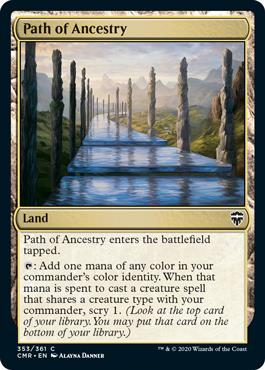
Path of Ancestry is more common, but it’s important to note that it’ll let you scry before the cascade trigger resolves, letting you filter out a bad free spell.
The Strategy
This deck is looking to assemble its infinite damage combo or just beat your opponents to dust with an army of suped-up slivers.
It’s really important that you ramp and set up your mana base in the early turns. I try to keep any opening hand that has a Manaweft Sliver and a way to cast it. Keeping a hand with multiple combo pieces is also recommended since you’ll typically only be able to Shared Summons once and Homing Sliver quickly becomes a target.
Midgame should see your board becoming a sizable threat. You want to cast The First Sliver as soon as possible and try to cast an extra sliver that turn if you’re able. While four or five slivers won’t be a game-ending board state, seven or eight can be.
By the late game you want to have the board presence to start swinging in with lethal damage. Dig up a Sliver Hivelord or Crypt Sliver to protect your board or get Patriarch's Bidding to swarm the field with the slivers your foes have spent so long culling. Try hitting a Glimpse of Tomorrow to rework your board into a new combination if you don’t have the right mix of slivers to win.
The best alternative if you’ve been locked out of your combat-damage win is to set up the Morophon combo. This is a tad bit harder and very fragile since it runs a lot of creatures, which can easily be removed. But it doesn’t broadcast itself very loudly and a lot of players assume you’re reassembling a value-filled battlefield.
Combos and Interactions
The most important combo in this deck is your win condition.
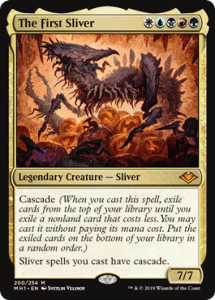



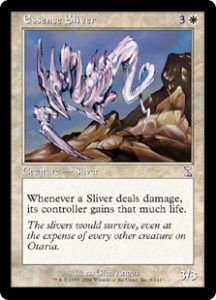

First you need all five creatures on the field: The First Sliver, Morophon, the Boundless, Hibernation Sliver, Lavabelly Sliver, and either Essence Sliver or Syphon Sliver. You also need at least three life.
Next, activate The First Sliver’s “hibernation” ability by paying two life to return it to your hand. Then cast it by paying zero (since Morophon reduces its cost by ). Its cascade ability will trigger while it’s on the stack, causing you to cascade. Lavabelly Sliver’s ability will trigger when it enters the battlefield, dealing one damage and gaining you one life.
Then Essence Sliver triggers, causing you to gain more life. This allows you to return The First Sliver to your hand and do the whole thing over again, resulting in infinite lifegain, infinite damage, an infinite storm count, and infinite cascades.
This combo is susceptible to both removal and counterspells since it relies entirely on creatures and has one step that needs to be cast at sorcery-speed (casting The First Sliver from your hand). But you can mitigate this with the protection and recursion slivers in the rest of the deck.
Rule 0 Violations Check
Some folks don’t appreciate playing against infinite combos, and that’s fine for them I guess. This deck can run just fine without activating the combo. I wouldn’t even advise making cuts to replace those cards if you don’t want to because the chances that you stumble into infinite damage are very slim, especially if you aren’t tutoring for those cards specifically.
Budget Options

Galerider Sliver | Illustration by James Zapata
This deck currently sits at a little above $300, which is a little more expensive than your average EDH deck. Let’s examine some budget options for The First Sliver.
Cheaper
There are a ton of easy cuts to reduce the cost of this deck, a lot of which can be substituted with more slivers.
First you can cut the infinite damage combo by dropping Morophon, the Boundless, Essence Sliver, and Syphon Sliver. The deck will still have legs, especially if you replace them with more combat-oriented slivers like Spiteful Sliver or more recursion like Dregscape Sliver.
And don’t be scared of dropping Sliver Hivelord and Sliver Legion if they’re too expensive, either. They often end up as overkill once they hit the board.
If it’s still a little steep, swap out Door of Destinies for some slower tribal support like Herald's Horn or Adaptive Automaton.
More Expensive
I always say consistency is the best way to punch-up a Commander deck, so let’s take a look at some upgrades.
Sensei's Divining Top is amazing in a cascade deck and is the absolute best way to set up the top of your library. Worldly Tutor lets you search up the sliver you need and it's cheap enough you’ll have the mana to cascade into it that turn.
There are also the other legendary slivers to consider. Sliver Overlord is the perfect tutor and Sliver Queen is the cheapest way to make extra sliver tokens.
Other Builds
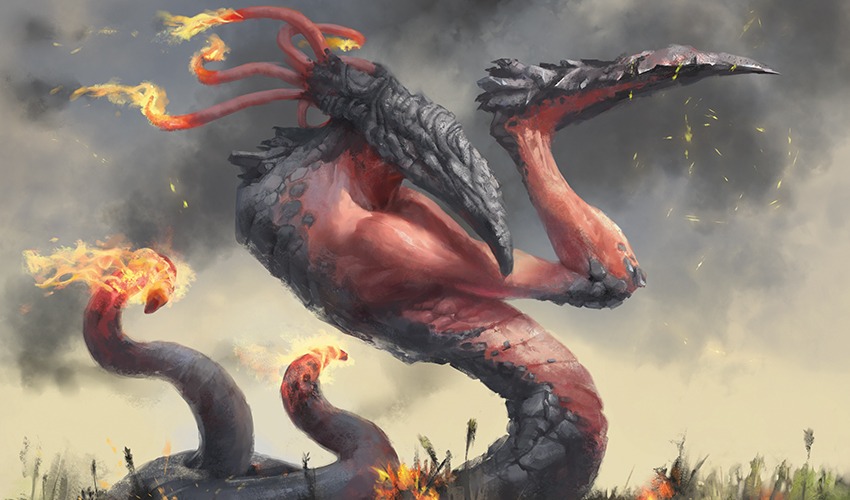
Lavabelly Sliver | Illustration by Mark Behm
It may seem like The First Sliver is a one-trick pony at first glance, but that’s definitely not the case with any 5-color commander. Other builds for The First Sliver can focus more on its cascade ability or on a broader creature type-themed deck.
The First Sliver is an incredibly reliable source of cascade, and you can possibly cast five or more free spells each turn by tweaking the deck. Having access to all five colors means you can run Maelstrom Nexus and Yidris, Maelstrom Wielder, making good use of new cards like Rain of Riches and Volcanic Torrent.
Or you can go the broader tribal route. This build involves running changeling creatures and the best tribal buffs available. I suggest including Conspiracy and Arcane Adaptation to open the deck up to even more creatures so you aren’t locked into changelings alone.
Commanding Conclusion
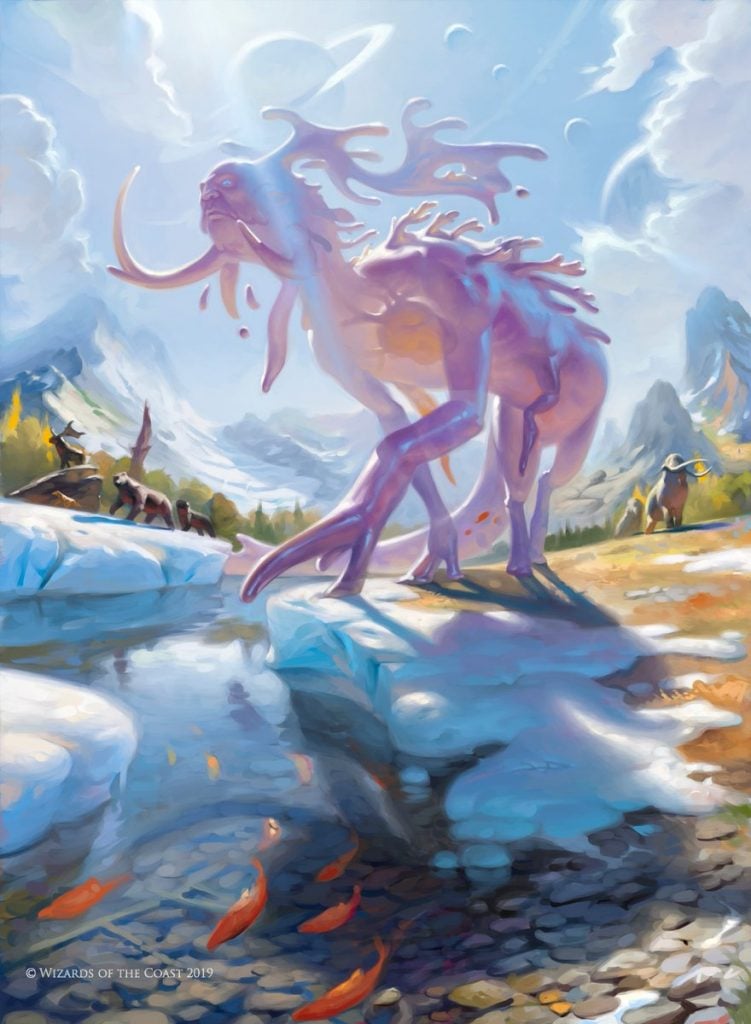
Morophon, the Boundless | Illustration by Victor Adame Minguez
The First Sliver is a mechanically unique Commander for sliver decks. While not as oppressive or powerful as Sliver Queen or Sliver Overlord, it plays an exciting game nonetheless with options to be built competitively or casually. It’s The First Sliver’s variety of playstyles that makes it one of the best slivers.
What do you think? Are there any much-needed slivers I’ve omitted? What would you like to see out of a new legendary sliver creature? Let me know in the comments or over on Draftsim’s Twitter.
Thanks for reading, happy hive-ing!
Follow Draftsim for awesome articles and set updates: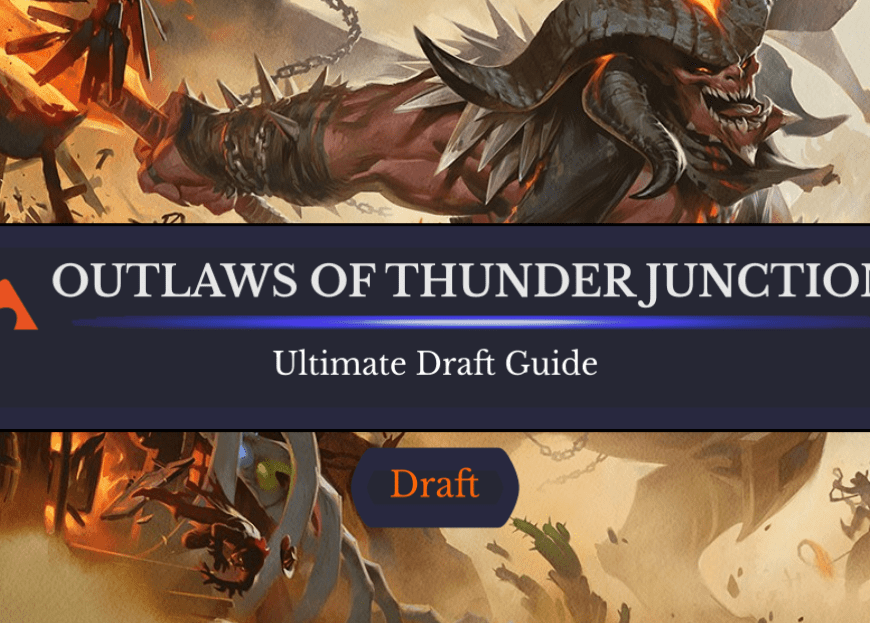
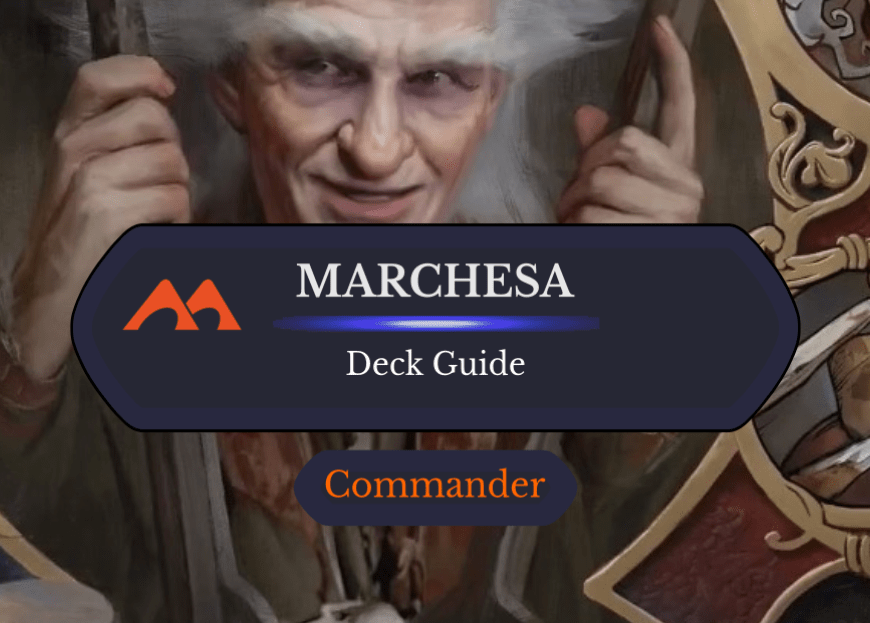
Add Comment